A Novel Numerical Method for Geothermal Reservoirs Embedded with Fracture Networks and Parameter Optimization for Power Generation
Abstract
1. Introduction
2. Materials and Methods Governing Equations for Fluid Flow and Heat Transfer
2.1. Fluid Flow in the Fracture and Rock Matrix
2.2. Heat Transport in the Fracture and Rock Matrix
3. Thermo-Hydromechanical Analysis in an EGS
3.1. Evolution of Porosity and Permeability in a Porous Matrix
3.2. THM Model for the Evolution of the Fracture Aperture
3.3. THM Model for the Evolution of Fluid Properties
4. The Method of Establishing a Numerical Model for Enhanced Geothermal Systems
4.1. Geometric Simplification of Fractures and Wellbores
4.2. Model Reliability Verification
4.3. The Application of the Proposed Method
5. Optimization of the Mining Parameters for Enhanced Geothermal Systems
5.1. The Objective Function for Geothermal Power Generation
5.2. The Optimization Method
- (1)
- Generate initial vectors and by suing and . Determine the random parameters .
- (2)
- A synchronous random disturbance is generated according to the random sequence , and each element in is independent and obeys a Gaussian distribution. The elements generated in each iterative step satisfy the Bernoulli distribution, that is, each element in satisfies the random number in the range [−1, 1];
- (3)
- Calculate the objective function values and with disturbance;
- (4)
- Calculate the stochastic approximate gradient for each variable:;
- (5)
- Update the estimated value based on ;
- (6)
- Repeat step (2) until the convergence condition is satisfied.
5.3. Results of Reservoir Optimization
6. Conclusions
- (1)
- The geometry of the wellbore and fracture can be simplified to enable easy implementation of large-scale calculations. Compared with a geometrically unreduced model, the method proposed in this study shows strong robustness, a fast calculation speed, and an accuracy that meets the requirements.
- (2)
- The proposed method is applied to investigate the development and utilization of deep geothermal resources. The results show that the generation power efficiency, the depletion of the reservoir and the production efficiency are highly correlated to the injection and production pressures. By maintaining injection/producer well pressures that are above the initial fluid pressure in the reservoir, one can significantly increase power generation, but the consumption of geothermal energy and efficiency losses are significant and rapid.
- (3)
- By optimizing the location and head pressure of production wells, the full use of geothermal resources and geothermal recovery can be adjusted according to the demand for electricity. According to the actual power generation application of an EGS, the net power generation is taken as the objective function, and the position and pressure of each production well are simultaneously optimized according to the difference in injection amount and injection water temperature in different seasons. The results show that after optimization, the temperature of each production well can remain above the lowest temperature required for power generation, and the power generation is also increased significantly.
Author Contributions
Funding
Institutional Review Board Statement
Informed Consent Statement
Data Availability Statement
Conflicts of Interest
References
- Willems, C.J.L.; Nick, H.M. Towards optimisation of geothermal heat recovery: An example from the West Netherlands Basin. Appl. Energy 2019, 247, 582–593. [Google Scholar] [CrossRef]
- Zhao, Y.; Feng, Z.; Feng, Z.; Yang, D.; Liang, W. THM (Thermo-hydro-mechanical) coupled mathematical model of fractured media and numerical simulation of a 3D enhanced geothermal system at 573 K and buried depth 6000–7000 M. Energy 2015, 82, 193–205. [Google Scholar] [CrossRef]
- Gan, Q.; Elsworth, D. Production optimization in fractured geothermal reservoirs by coupled discrete fracture network modeling. Geothermics 2016, 62, 131–142. [Google Scholar] [CrossRef]
- Shaik, A.R.; Rahman, S.S.; Tran, N.H.; Tran, T. Numerical simulation of Fluid-Rock coupling heat transfer in naturally fractured geothermal system. Appl. Therm. Eng. 2011, 31, 1600–1606. [Google Scholar] [CrossRef]
- Li, S.; Feng, X.-T.; Zhang, D.; Tang, H. Coupled thermo-hydro-mechanical analysis of stimulation and production for fractured geothermal reservoirs. Appl. Energy 2019, 247, 40–59. [Google Scholar] [CrossRef]
- Wang, W.X.; Sui, W.H.; Faybishenko, B.; Stringfellow, W.T. Permeability variations within mining-induced fractured rock mass and its influence on groundwater inrush. Environ. Earth Sci. 2016, 75, 326. [Google Scholar] [CrossRef]
- Zhang, S.; Fan, G.; Zhang, D.; Li, S.; Chen, M.; Fan, Y.; Luo, T. Impacts of longwall mining speeds on permeability of weakly cemented strata and subsurface watertable: A case study. Geomat. Nat. Hazards Risk 2021, 12, 3063–3088. [Google Scholar] [CrossRef]
- Liu, X.; Liu, Q.; Liu, B.; Kang, Y.; He, J. Numerical manifold method for thermal–hydraulic coupling in fractured enhance geothermal system. Eng. Anal. Bound. Elem. 2019, 101, 67–75. [Google Scholar] [CrossRef]
- Zhang, L.; Jiang, P.; Wang, Z.; Xu, R. Convective heat transfer of supercritical CO2 in a rock fracture for enhanced geothermal systems. Appl. Therm. Eng. 2017, 115, 923–936. [Google Scholar] [CrossRef]
- Na, J.; Xu, T.; Yuan, Y.; Feng, B.; Tian, H.; Bao, X. An integrated study of fluid–rock interaction in a CO2-based enhanced geothermal system: A case study of Songliao Basin, China. Appl. Geochem. 2015, 59, 166–177. [Google Scholar] [CrossRef]
- Faigle, B.; Elfeel, M.A.; Helmig, R.; Becker, B.; Flemisch, B.; Geiger, S. Multi-physics modeling of non-isothermal compositional flow on adaptive grids. Comput. Methods Appl. Mech. Eng. 2015, 292, 16–34. [Google Scholar] [CrossRef]
- Xu, J.; Yang, K. Well-posedness and robust preconditioners for discretized fluid–structure interaction systems. Comput. Methods Appl. Mech. Eng. 2015, 292, 69–91. [Google Scholar] [CrossRef]
- Zhang, Y.; Zhuang, X. Cracking elements: A self-propagating Strong Discontinuity embedded Approach for quasi-brittle fracture. Finite Elem. Anal. Des. 2018, 144, 84–100. [Google Scholar] [CrossRef]
- Koh, J.; Roshan, H.; Rahman, S.S. A numerical study on the long term thermo-poroelastic effects of cold water injection into naturally fractured geothermal reservoirs. Comput. Geotech. 2011, 38, 669–682. [Google Scholar] [CrossRef]
- Jiang, F.; Luo, L.; Chen, J. A novel three-dimensional transient model for subsurface heat exchange in enhanced geothermal systems. Int. Commun. Heat Mass Transf. 2013, 41, 57–62. [Google Scholar] [CrossRef]
- Zeng, Y.-C.; Su, Z.; Wu, N.-Y. Numerical simulation of heat production potential from hot dry rock by water circulating through two horizontal wells at Desert Peak geothermal field. Energy 2013, 56, 92–107. [Google Scholar] [CrossRef]
- Huang, W.; Cao, W.; Jiang, F. Heat extraction performance of EGS with heterogeneous reservoir: A numerical evaluation. Int. J. Heat Mass Transf. 2017, 108, 645–657. [Google Scholar] [CrossRef]
- Huang, W.; Cao, W.; Guo, J.; Jiang, F. An analytical method to determine the fluid-rock heat transfer rate in two-equation thermal model for EGS heat reservoir. Int. J. Heat Mass Transf. 2017, 113, 1281–1290. [Google Scholar] [CrossRef]
- Yan, C.; Jiao, Y.-Y.; Yang, S. A 2D coupled hydro-thermal model for the combined finite-discrete element method. Acta Geotech. 2018, 14, 403–416. [Google Scholar] [CrossRef]
- Jasinski, L.; Dabrowski, M. The Effective Transmissivity of a Plane-Walled Fracture With Circular Cylindrical Obstacles. J. Geophys. Res. Solid Earth 2018, 123, 242–263. [Google Scholar] [CrossRef]
- Hyman, J.D.; Aldrich, G.; Viswanathan, H.; Makedonska, N.; Karra, S. Fracture size and transmissivity correlations: Implications for transport simulations in sparse three-dimensional discrete fracture networks following a truncated power law distribution of fracture size. Water Resour. Res. 2016, 52, 6472–6489. [Google Scholar] [CrossRef]
- Fairley, J.P. Fracture/matrix interaction in a fracture of finite extent. Water Resour. Res. 2010, 46, 1–11. [Google Scholar] [CrossRef]
- Li, L.; Jiang, H.; Li, J.; Wu, K.; Meng, F.; Xu, Q.; Chen, Z. An analysis of stochastic discrete fracture networks on shale gas recovery. J. Pet. Sci. Eng. 2018, 167, 78–87. [Google Scholar] [CrossRef]
- Lei, Q.; Latham, J.-P.; Tsang, C.-F. The use of discrete fracture networks for modelling coupled geomechanical and hydrological behaviour of fractured rocks. Comput. Geotech. 2017, 85, 151–176. [Google Scholar] [CrossRef]
- Hyman, J.D.; Karra, S.; Makedonska, N.; Gable, C.W.; Painter, S.L.; Viswanathan, H.S. dfnWorks: A discrete fracture network framework for modeling subsurface flow and transport. Comput. Geosci. 2015, 84, 10–19. [Google Scholar] [CrossRef]
- Figueiredo, B.; Tsang, C.-F.; Rutqvist, J.; Niemi, A. A study of changes in deep fractured rock permeability due to coupled hydro-mechanical effects. Int. J. Rock Mech. Min. Sci. 2015, 79, 70–85. [Google Scholar] [CrossRef]
- Akın, S.; Kok, M.V.; Uraz, I. Optimization of well placement geothermal reservoirs using artificial intelligence. Comput. Geosci. 2010, 36, 776–785. [Google Scholar] [CrossRef]
- Chen, J.; Jiang, F. Designing multi-well layout for enhanced geothermal system to better exploit hot dry rock geothermal energy. Renew. Energy 2015, 74, 37–48. [Google Scholar] [CrossRef]
- Zeng, Y.-C.; Wu, N.-Y.; Su, Z.; Wang, X.-X.; Hu, J. Numerical simulation of heat production potential from hot dry rock by water circulating through a novel single vertical fracture at Desert Peak geothermal field. Energy 2013, 63, 268–282. [Google Scholar] [CrossRef]
- Duniam, S.; Gurgenci, H. Annual performance variation of an EGS power plant using an ORC with NDDCT cooling. Appl. Therm. Eng. 2016, 105, 1021–1029. [Google Scholar] [CrossRef]
- Xu, T.; Yuan, Y.; Jia, X.; Lei, Y.; Li, S.; Feng, B.; Hou, Z.; Jiang, Z. Prospects of power generation from an enhanced geothermal system by water circulation through two horizontal wells: A case study in the Gonghe Basin, Qinghai Province, China. Energy 2018, 148, 196–207. [Google Scholar] [CrossRef]
- Meng, N.; Li, T.; Wang, J.; Jia, Y.; Liu, Q.; Qin, H. Synergetic mechanism of fracture properties and system configuration on techno-economic performance of enhanced geothermal system for power generation during life cycle. Renew. Energy 2020, 152, 910–924. [Google Scholar] [CrossRef]
- Patil, V.R.; Biradar, V.I.; Shreyas, R.; Garg, P.; Orosz, M.S.; Thirumalai, N.C. Techno-economic comparison of solar organic Rankine cycle (ORC) and photovoltaic (PV) systems with energy storage. Renew. Energy 2017, 113, 1250–1260. [Google Scholar] [CrossRef]
- Zimmerman, R.W.; Bodvarsson, G.S. Hydraulic conductivity of rock fractures. Transp. Porous Media 1996, 23, 1–30. [Google Scholar] [CrossRef]
- Ghassemi, A.; Zhou, X. A three-dimensional thermo-poroelastic model for fracture response to injection/extraction in enhanced geothermal systems. Geothermics 2011, 40, 39–49. [Google Scholar] [CrossRef]
- Gao, Y.; Guo, P.; Zhang, Z.; Li, M.; Gao, F.; Wang, Y. Migration of the Industrial Wastewater in Fractured Rock Masses Based on the Thermal-Hydraulic-Mechanical Coupled Model. Geofluids 2021, 2021, 5473719. [Google Scholar] [CrossRef]
- Bohnsack, D.; Potten, M.; Pfrang, D.; Wolpert, P.; Zosseder, K. Porosity–permeability relationship derived from Upper Jurassic carbonate rock cores to assess the regional hydraulic matrix properties of the Malm reservoir in the South German Molasse Basin. Geotherm. Energy 2020, 8, 12. [Google Scholar] [CrossRef]
- Júnior, V.A.S.; Júnior, A.F.S.; Simões, T.A.; Oliveira, G.P. Poiseuille-Number-Based Kozeny–Carman Model for Computation of Pore Shape Factors on Arbitrary Cross Sections. Transp. Porous Media 2021, 138, 99–131. [Google Scholar] [CrossRef]
- Rutqvist, J.; Wu, Y.-S.; Tsang, C.-F.; Bodvarsson, G. A modeling approach for analysis of coupled multiphase fluid flow, heat transfer, anddeformation in fracturedporous rock. Int. J. Rock Mech. Min. Sci. 2002, 39, 11. [Google Scholar] [CrossRef]
- Min, K.-B.; Rutqvist, J.; Elsworth, D. Chemically and mechanically mediated influences on the transport and mechanical characteristics of rock fractures. Int. J. Rock Mech. Min. Sci. 2009, 46, 80–89. [Google Scholar] [CrossRef]
- Brown, S.R.; Scholz, C.H. Closure of rock joints. J. Geophys. Res. 1986, 91, 4939–4948. [Google Scholar] [CrossRef]
- Baldino, S.; Meng, M. Critical review of wellbore ballooning and breathing literature. Geomech. Energy Environ. 2021, 28, 100252. [Google Scholar] [CrossRef]
- Chen, Y.; Ma, G.; Wang, H.; Li, T. Evaluation of geothermal development in fractured hot dry rock based on three dimensional unified pipe-network method. Appl. Therm. Eng. 2018, 136, 219–228. [Google Scholar] [CrossRef]
- Mahmoodpour, S.; Singh, M.; Bär, K.; Sass, I. Thermo-hydro-mechanical modeling of an enhanced geothermal system in a fractured reservoir using carbon dioxide as heat transmission fluid—A sensitivity investigation. Energy 2022, 254, 124266. [Google Scholar] [CrossRef]
- Mahmoodpour, S.; Singh, M.; Turan, A.; Bär, K.; Sass, I. Simulations and global sensitivity analysis of the thermo-hydraulic-mechanical processes in a fractured geothermal reservoir. Energy 2022, 247, 123511. [Google Scholar] [CrossRef]
- Mahmoodpour, S.; Singh, M.; Bär, K.; Sass, I. Impact of Well Placement in the Fractured Geothermal Reservoirs Based on Available Discrete Fractured System. Geosciences 2022, 12, 19. [Google Scholar] [CrossRef]
- Mahmoodpour, S.; Singh, M.; Turan, A.; Bär, K.; Sass, I. Hydro-Thermal Modeling for Geothermal Energy Extraction from Soultz-sous-Forêts, France. Geosciences 2021, 11, 464. [Google Scholar] [CrossRef]

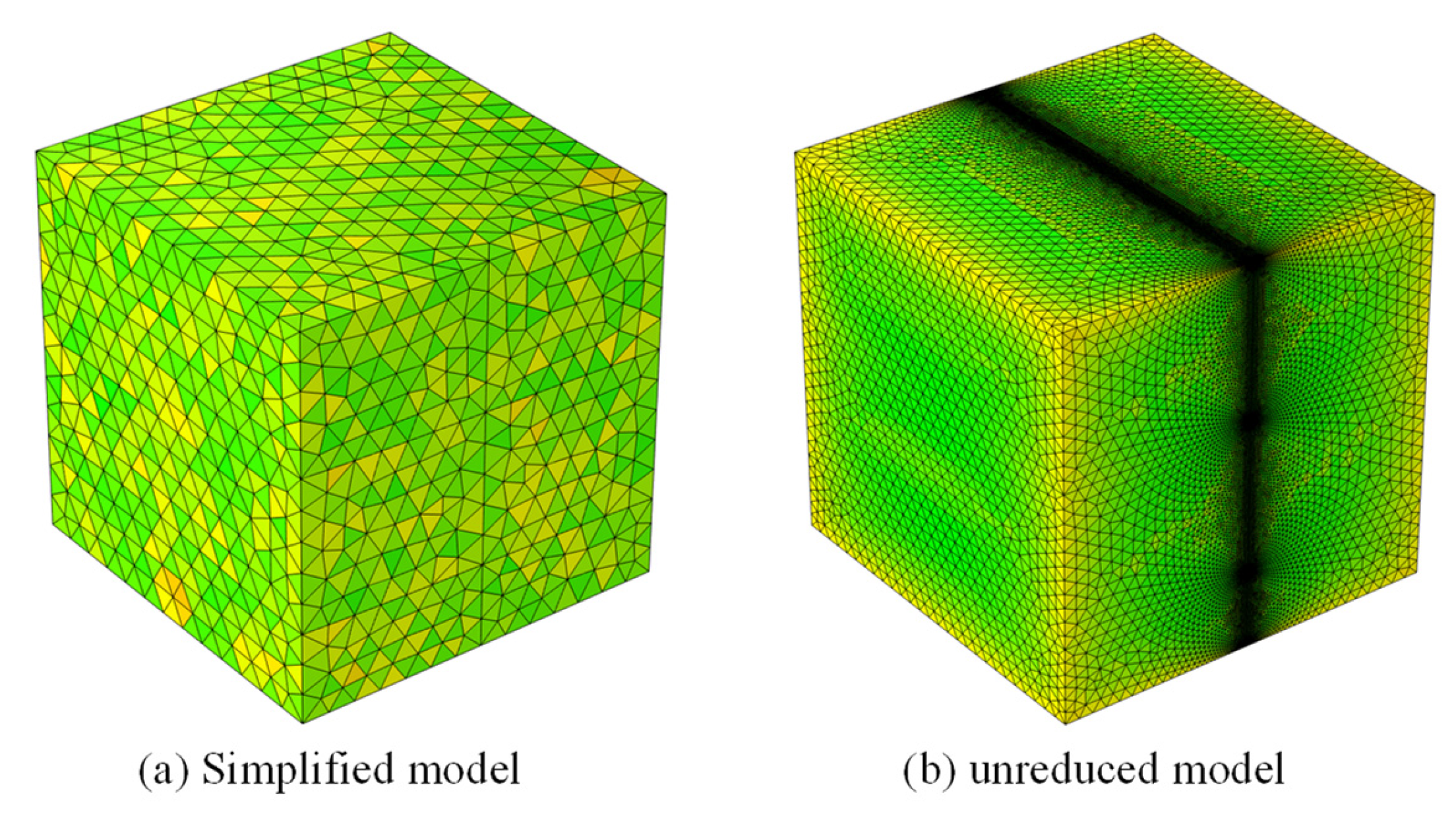
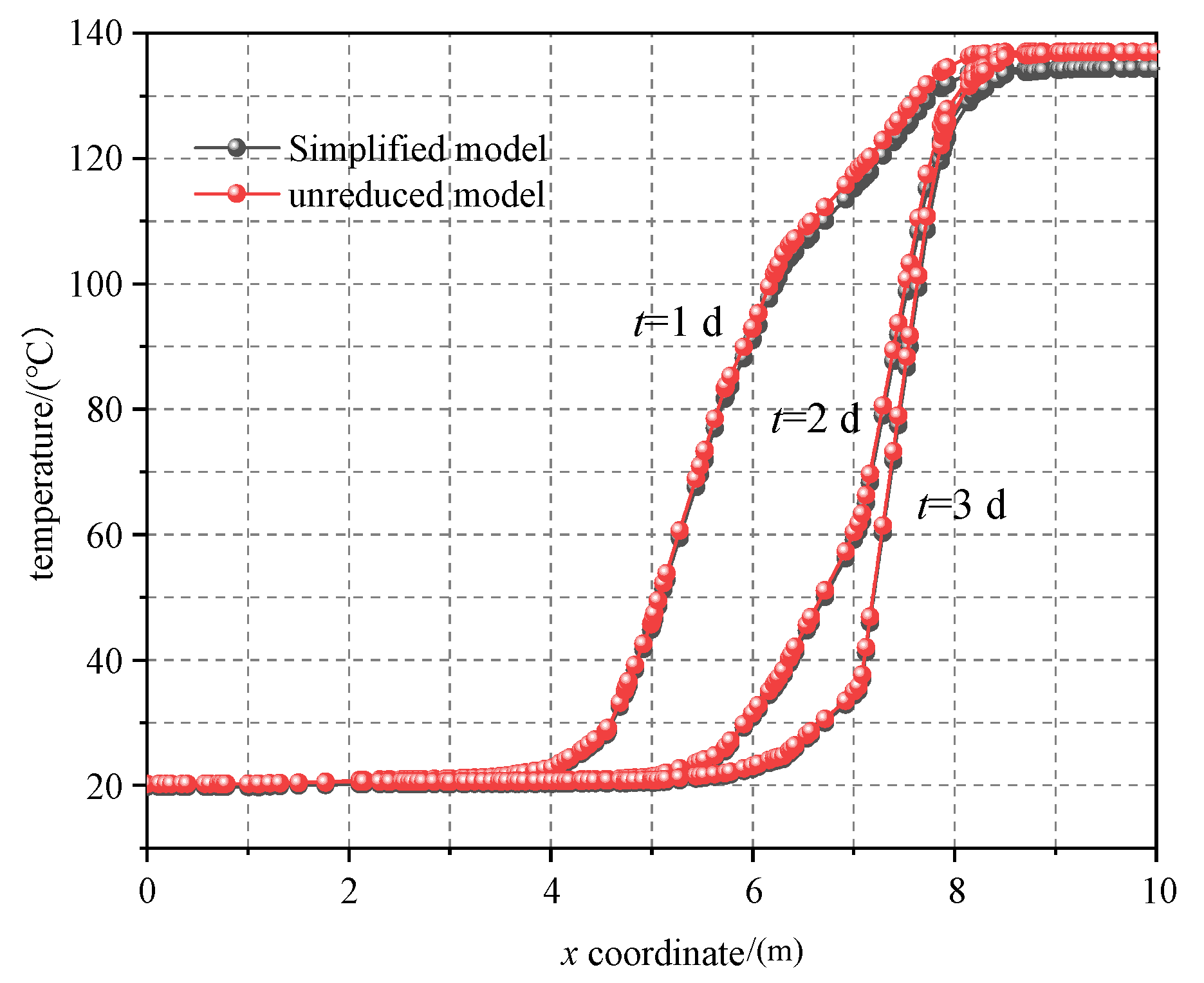
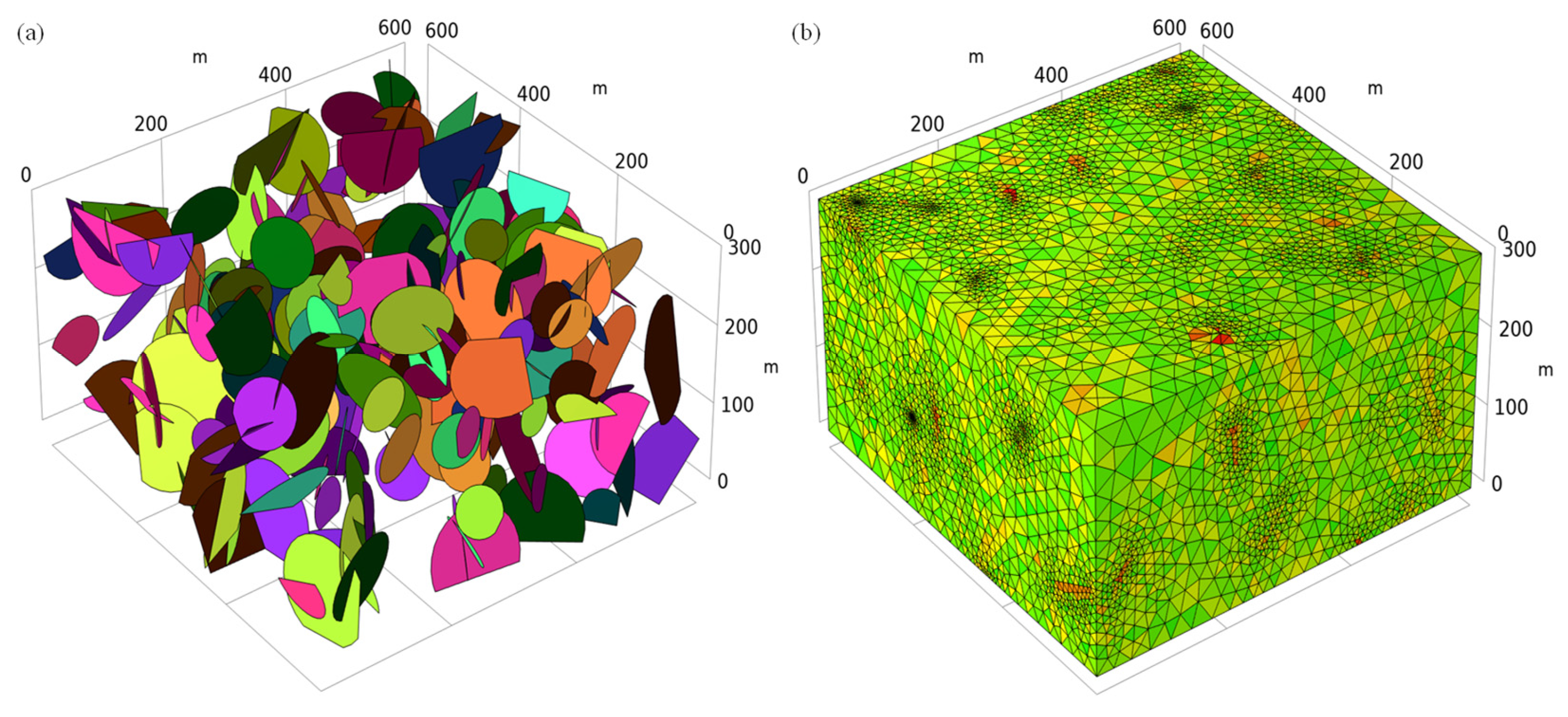
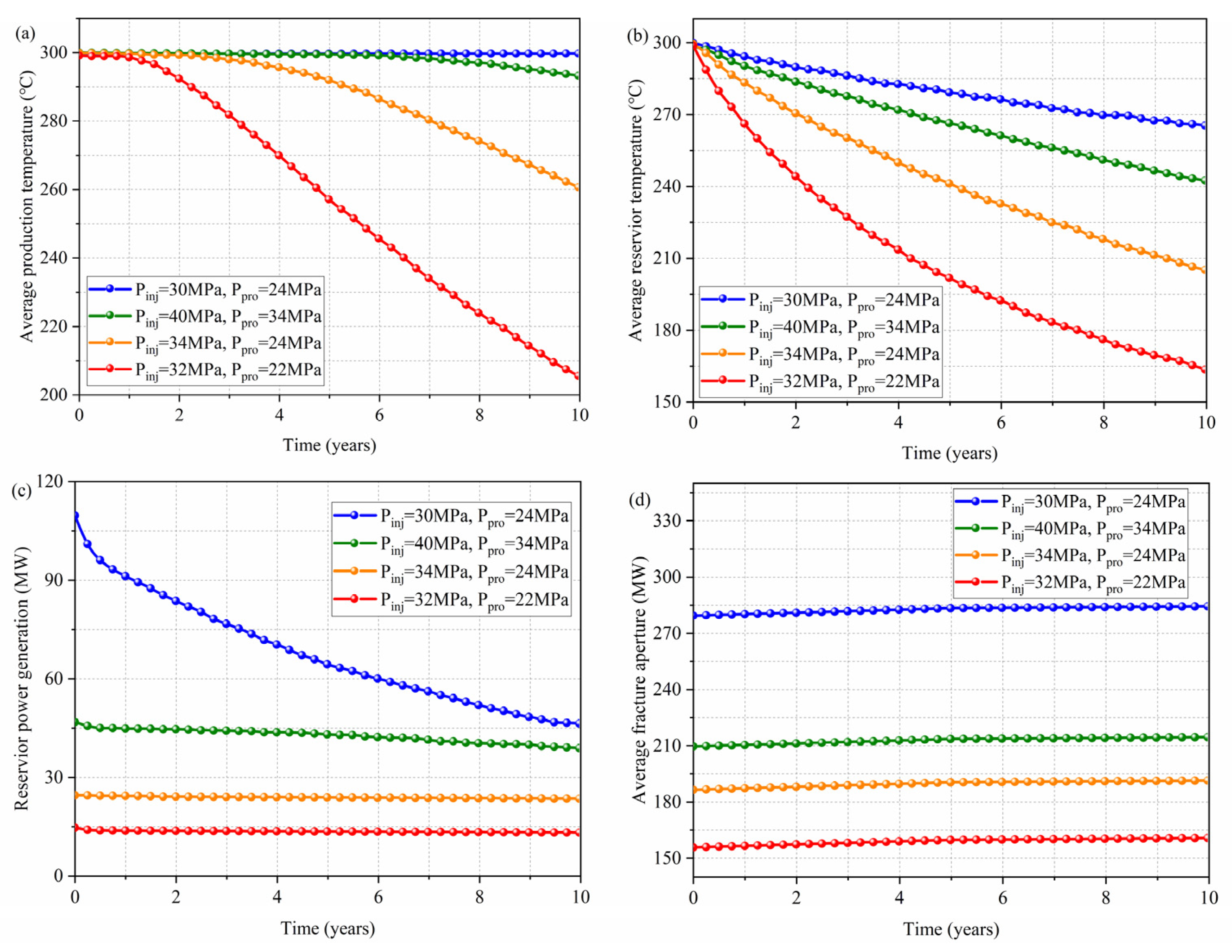
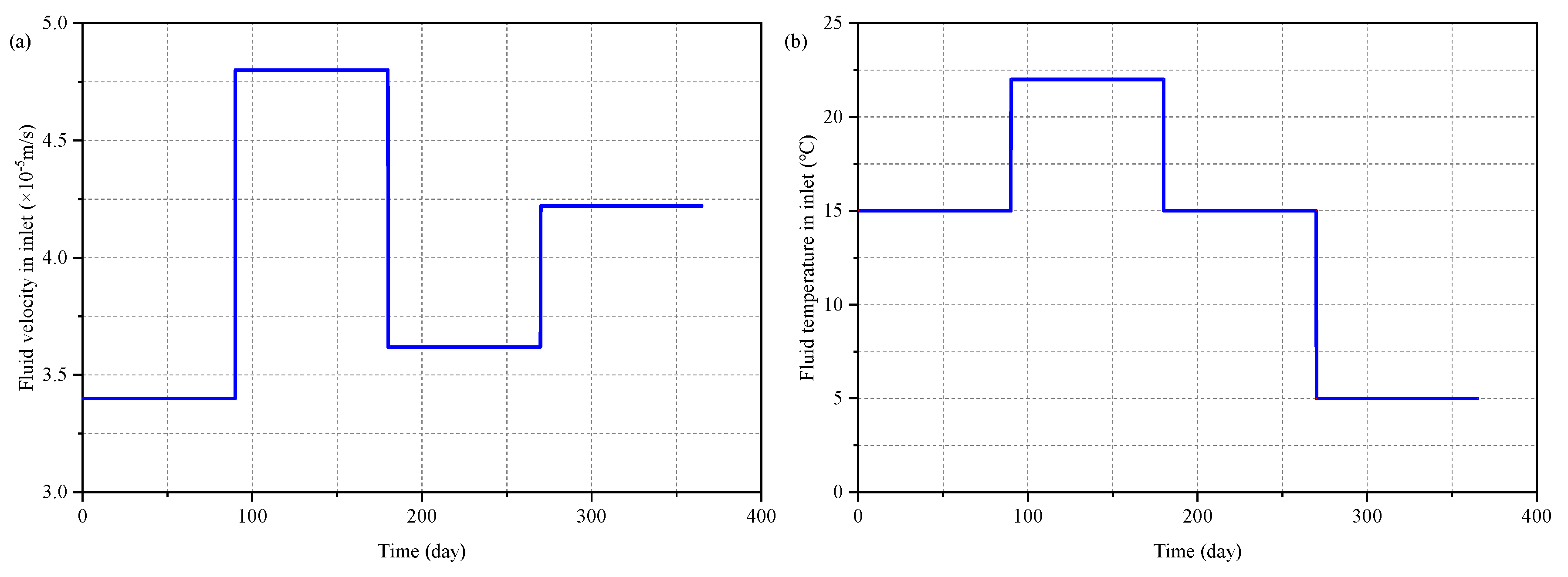
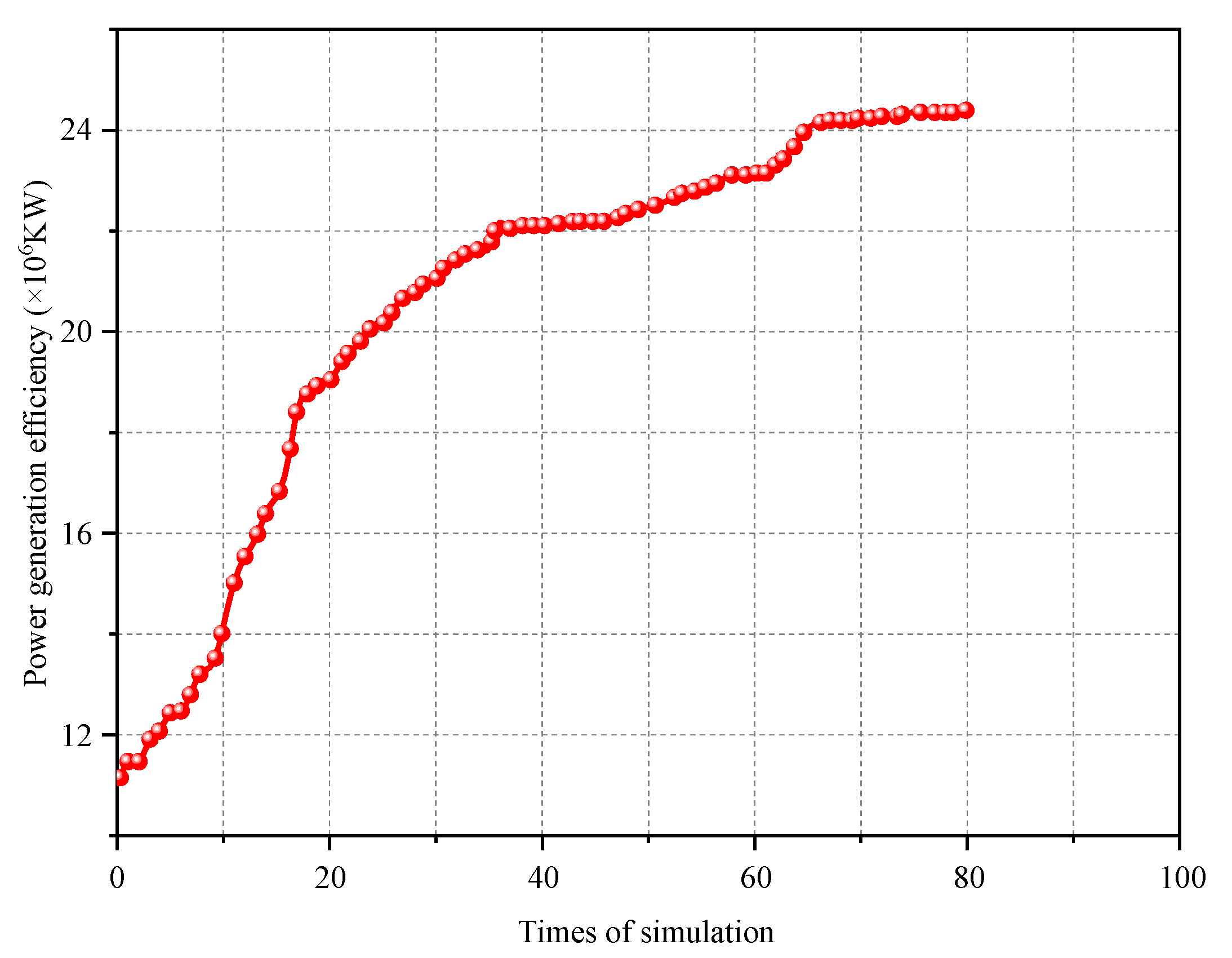
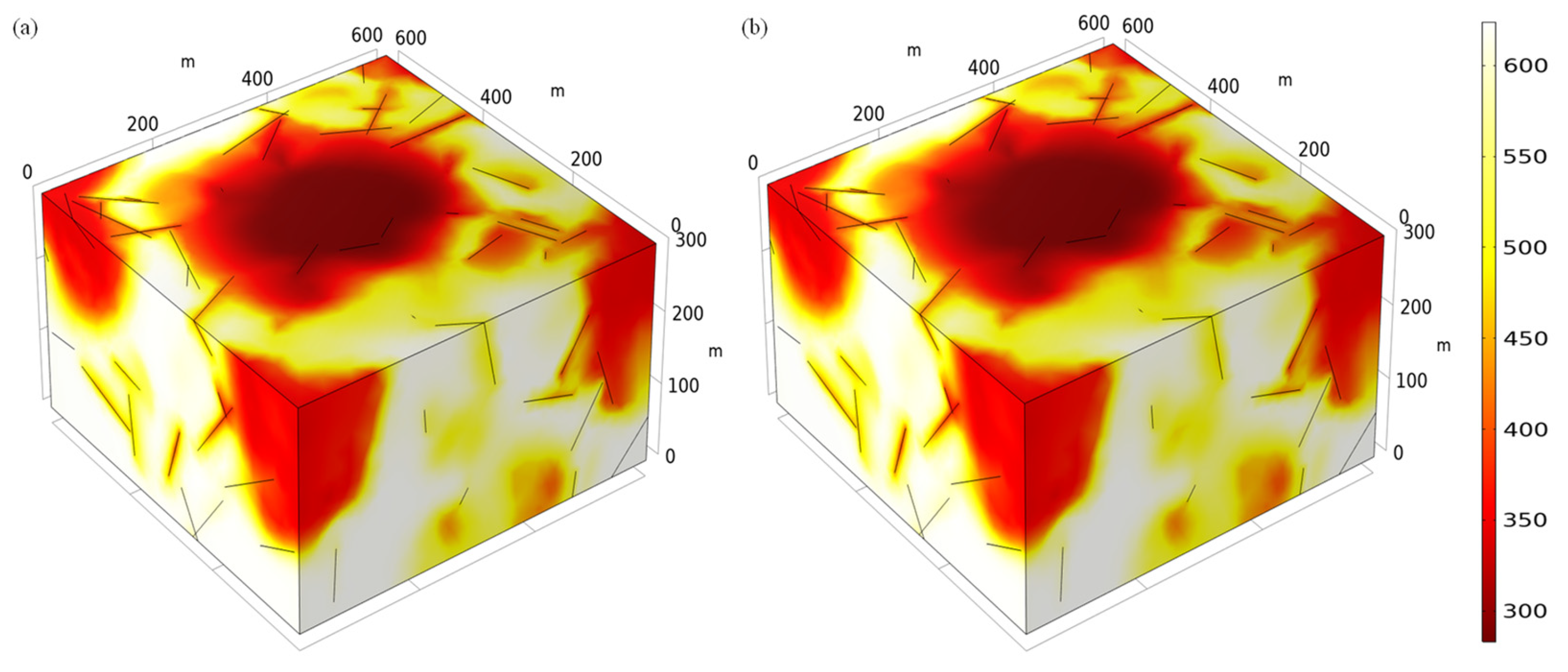
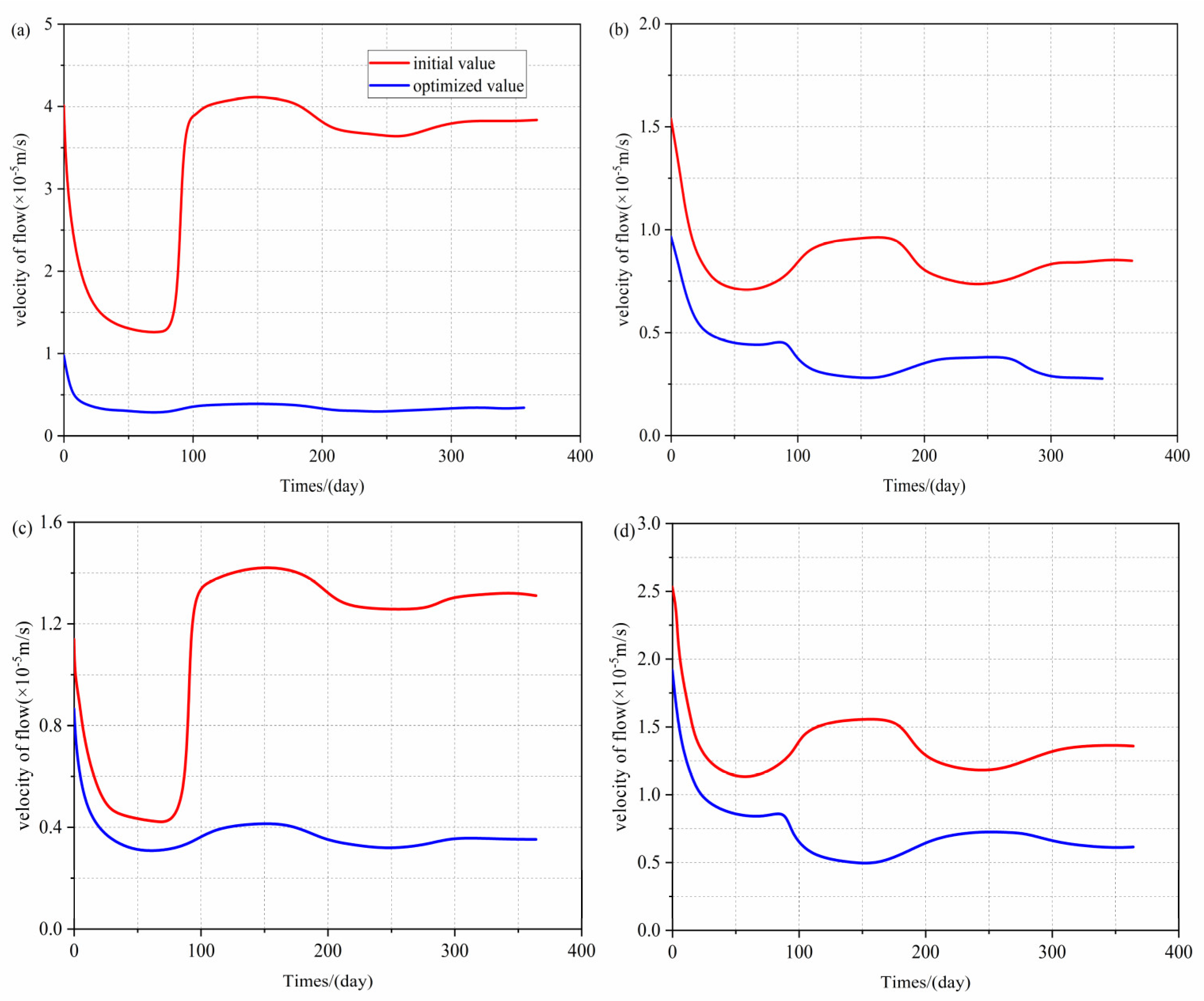

| Properties of the Fluid | Properties of the Rock Matrix | ||
|---|---|---|---|
| Density | 1000 kg/m3 | Permeability | 1.0 × 10−16 m2 |
| Viscosity | 0.001 Pa·S | Fracture aperture | 1 mm |
| Specific heat capacity | 4200 J/(kg·K) | Specific heat capacity | 1000 J/(kg·K) |
| Thermal conductivity | 0.6 W/(M·K) | Thermal conductivity | 3 W/(m·K) |
| Parameter | Symbol | Value | Unit |
|---|---|---|---|
| Properties of rock matrix | |||
| Young’s modulus | E | 10 | GPa |
| Poisson’s ratio | ν | 0.25 | |
| Density | ρm | 2700 | kg/m3 |
| Thermal expansion coefficient | αT | 2 × 10−6 | 1/°C |
| Thermal conductivity coefficient | λm | 3.5 | J/(m s °C) |
| Specific heat capacity | cm | 790 | J/(kg °C) |
| Properties of rock fracture | |||
| Initial aperture | e0 | 0.1 | mm |
| Normal stiffness | kn | 50 | GPa/m2 |
| Tangential stiffness | kt | 10 | GPa/m2 |
| Dilation angle | φ | 10 | degrees |
| Critical shear displacement for dilation | Ucs | 1 | mm |
| Properties of fluid | |||
| Density | ρf | 1000 | kg/m3 |
| Viscosity | µ | 0.001 | Pa s |
| Thermal conductivity coefficient | λf | 0.6 | J/(m s °C) |
| Specific heat capacity | cf | 4200 | J/(kg °C) |
| Parameter | Symbol | Value | Unit |
|---|---|---|---|
| Initial temperature of fluid in fractures | Tf,0 | 300 | °C |
| Initial temperature of reservoir | Tm,0 | 300 | °C |
| Inlet temperature of fluid | Tin | 20 | °C |
| Heat transfer coefficient | hint | 1000 | W/(m2·°C) |
| Initial water pressure in reservoir | P0 | 20 | MPa |
| Case 1 | |||
| Injection pressure | Pinj | 30 | MPa |
| Production pressure | Ppro | 24 | MPa |
| Case 2 | |||
| Injection pressure | Pinj | 40 | MPa |
| Production pressure | Ppro | 34 | MPa |
| Case 3 | |||
| Injection pressure | Pinj | 34 | MPa |
| Production pressure | Ppro | 24 | MPa |
| Case 4 | |||
| Injection pressure | Pinj | 32 | MPa |
| Production pressure | Ppro | 22 | MPa |
| Isentropic efficiency of working fluid pump | 0.65 |
| Isentropic efficiency of the expander | 0.85 |
| generator power | 0.95 |
| Inlet temperature of cooling water | 293.15 |
| Outlet temperature of cooling water | 298.05 |
| Production Well No. | Coordinate | Min/m | Max/m |
|---|---|---|---|
| 1 | X | 2 | 100 |
| Y | 2 | 100 | |
| 2 | X | 2 | 100 |
| Y | 500 | 598 | |
| 3 | X | 500 | 598 |
| Y | 2 | 100 | |
| 4 | X | 500 | 598 |
| Y | 500 | 598 |
| Production Well No. | Coordinate/m | Production Well Pressure/MPa | ||||
|---|---|---|---|---|---|---|
| X | Y | 0–90 | 90–180 | 180–270 | 270–360 | |
| 1 | 21.60 | 81.40 | 22 | 18.04 | 18.27 | 18.35 |
| 2 | 76.8 | 514.4 | 22 | 18.03 | 18.26 | 18.32 |
| 3 | 535.6 | 34.2 | 22 | 26.81 | 26.77 | 26.93 |
| 4 | 556.2 | 590.8 | 22 | 26.96 | 26.83 | 26.66 |
Disclaimer/Publisher’s Note: The statements, opinions and data contained in all publications are solely those of the individual author(s) and contributor(s) and not of MDPI and/or the editor(s). MDPI and/or the editor(s) disclaim responsibility for any injury to people or property resulting from any ideas, methods, instructions or products referred to in the content. |
© 2023 by the authors. Licensee MDPI, Basel, Switzerland. This article is an open access article distributed under the terms and conditions of the Creative Commons Attribution (CC BY) license (https://creativecommons.org/licenses/by/4.0/).
Share and Cite
Yan, X.; Xue, K.; Liu, X.; Chi, X. A Novel Numerical Method for Geothermal Reservoirs Embedded with Fracture Networks and Parameter Optimization for Power Generation. Sustainability 2023, 15, 9744. https://doi.org/10.3390/su15129744
Yan X, Xue K, Liu X, Chi X. A Novel Numerical Method for Geothermal Reservoirs Embedded with Fracture Networks and Parameter Optimization for Power Generation. Sustainability. 2023; 15(12):9744. https://doi.org/10.3390/su15129744
Chicago/Turabian StyleYan, Xufeng, Kangsheng Xue, Xiaobo Liu, and Xiaolou Chi. 2023. "A Novel Numerical Method for Geothermal Reservoirs Embedded with Fracture Networks and Parameter Optimization for Power Generation" Sustainability 15, no. 12: 9744. https://doi.org/10.3390/su15129744
APA StyleYan, X., Xue, K., Liu, X., & Chi, X. (2023). A Novel Numerical Method for Geothermal Reservoirs Embedded with Fracture Networks and Parameter Optimization for Power Generation. Sustainability, 15(12), 9744. https://doi.org/10.3390/su15129744







